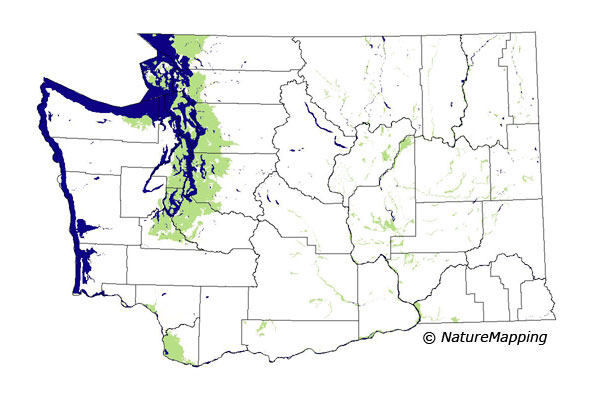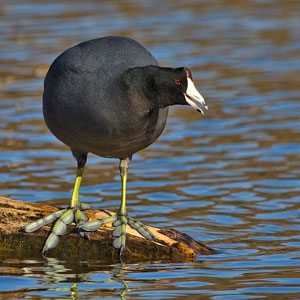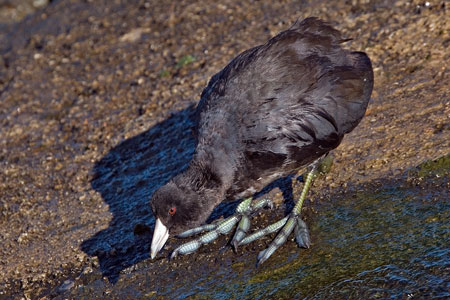

|
American Coot (Fulica americana) 
What they look like: American Coots are noisy, gregarious members of the rail family. The coot is a medium-sized diving bird with a white bill, yellow legs, and lobed toes. The feet look oversized for this bird. The body is dark gray to black with a blackish head and neck. Some of the undertail coverts are white and visible, especially during display. Juveniles are paler and have greenish-gray legs. The chick's downy plumage is a colorful orange on the head and neck. In flight, coots may be distinguished by a white trailing edge on most of the wing. 
Call: Makes scratchy clucking noises and series of "kuk-kuk-kuk" notes. Listen to calls of this species » Where they live: American Coots are common at lower elevations in large freshwater ponds, lakes, and slow-moving rivers at lower elevations throughout the state. For nesting, they require tall marsh vegetation in shallow water. Other times of the year, they will occasionally visit salt marshes and protected coastal bays.
In western Washington, coots are limited to the Puget Trough and the Columbia River due to a lack of suitable water bodies elsewhere. Along the coast, where they are rare, they are possibly only found in sewage lagoons. Click the range map to learn more about the distribution of American Coots in Washington. What they eat: American Coots are opportunistic feeders - they eat what is available. Coots mainly eat plant material, but will also feed on insects, fish, tadpoles, snails, worms, and eggs of other birds. Nesting: The nest, built by both the male and female, is a floating platform made of stems of marsh plants. It is concealed in vegetation and anchored to surrounding plants. Females lay 6-11 eggs which both sexes incubate. The young are able to swim soon after hatching and follow the parents to be fed. Pairs may have one to two broods per year. 
Behavior: Coots propel themselves through the water by pumping their heads back and forth. Flocks forage along the shore or on lawns. Coots also dive for aquatic plants. Males aggressively defend nesting territories, attacking each other with their feet. Migration: American Coots are permanent residents in the lowlands of eastern and western Washington. From late August through December, local birds and migrants often congregate on large bodies of water. Wintering flocks may be found in bays along the coast. Birds return to breeding areas in March and April. (BirdWeb)
Did you know?
Photos: American Coot photo gallery Videos: American Coot videos More Information: American Coot - All About BirdsAmerican Coot - BirdWeb American Coot - Sound to Sage | Breeding Bird Atlas Animal silhouettes available to purchase »
Photos: Natures Pics Home | About Us | How to Participate | Biodiversity Modules | Projects | Maps | News | Resources |